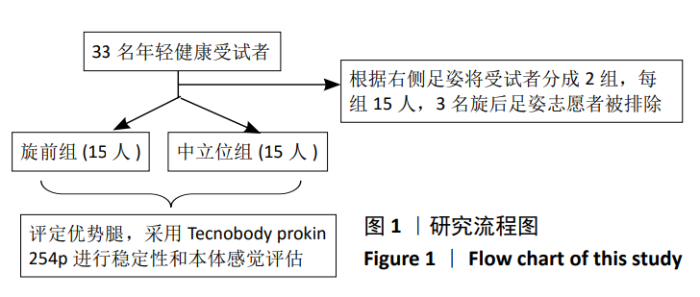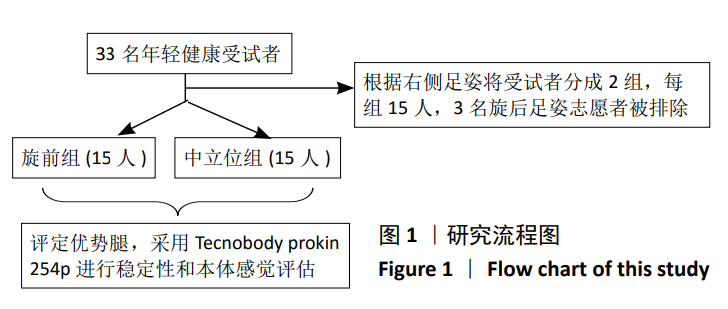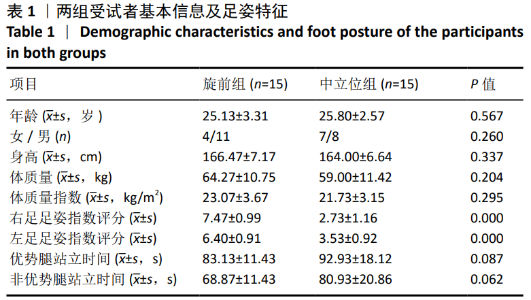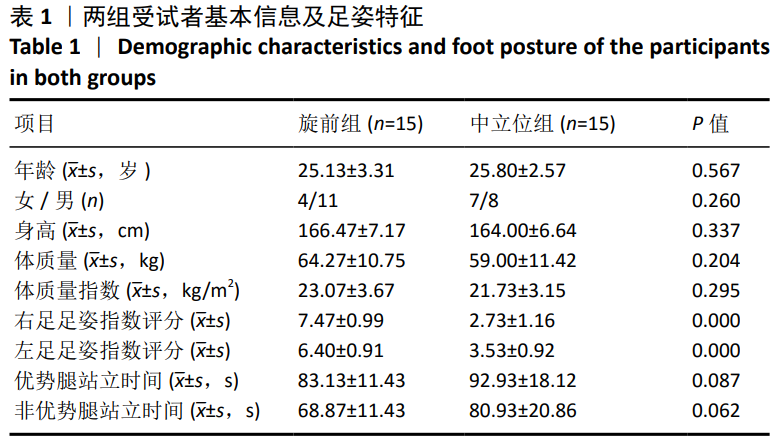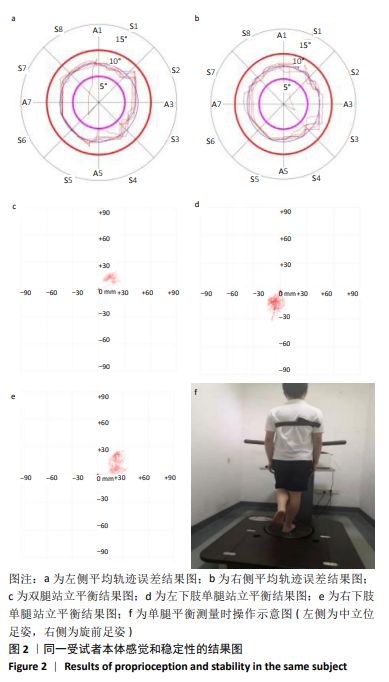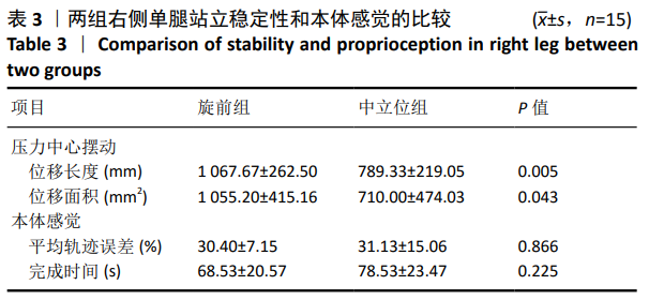Chinese Journal of Tissue Engineering Research ›› 2021, Vol. 25 ›› Issue (9): 1324-1328.doi: 10.3969/j.issn.2095-4344.3757
Previous Articles Next Articles
Effect of pronated foot posture on proprioception and postural stability based on foot posture index
Chen Zehua1, Ye Xiangling1, Chen Weijian1, Du Jianping1, 2, Liu Wengang1, 2, Xu Xuemeng1, 2
- 1Fifth Clinical Medical College of Guangzhou University of Chinese Medicine, Guangzhou 510405, Guangdong Province, China; 2Guangdong Second Traditional Chinese Medicine Hospital, Guangzhou 510405, Guangdong Province, China
-
Received:2020-03-06Revised:2020-03-11Accepted:2020-06-03Online:2021-03-28Published:2020-12-15 -
Contact:Xu Xuemeng, Professor, Chief physician, Doctoral supervisor, Fifth Clinical Medical College of Guangzhou University of Chinese Medicine, Guangzhou 510405, Guangdong Province, China; Guangdong Second Traditional Chinese Medicine Hospital, Guangzhou 510405, Guangdong Province, China -
About author:Chen Zehua, MD, Attending physician, Fifth Clinical Medical College of Guangzhou University of Chinese Medicine, Guangzhou 510405, Guangdong Province, China -
Supported by:the Guangdong Provincial Special Fund for Industrial and Information Development, No. Guangdong Finance and Industry [2016]69; the Soft Science Research Program of Guangdong Province, No. 2018B020207009; the Science and Technology Plan Project of Guangdong Province, No. 2019A141401008; the Science and Technology Plan Project of Guangzhou, No. 202002030204
CLC Number:
Cite this article
Chen Zehua, Ye Xiangling, Chen Weijian, Du Jianping, Liu Wengang, Xu Xuemeng. Effect of pronated foot posture on proprioception and postural stability based on foot posture index[J]. Chinese Journal of Tissue Engineering Research, 2021, 25(9): 1324-1328.
share this article
| [1] TINETTI ME, SPEECHLEY M, GINTER SF. Risk factors for falls among elderly persons living in the community.N Engl J Med.1988;319(26):1701-1707. [2] 张新语,霍洪峰.足姿指数(FPI):足部姿势及足踝功能的定量表达[J].中国矫形外科杂志,2019,27(13):1194-1199. [3] REDMOND AC, CROSBIE J,OUVRIER RA.Development and validation of a novel rating system for scoring standing foot posture: the foot posture index. Clin Biomech. 2006;21(1):89-98. [4] AQUINO MRC, AVELAR BS, SILVA PL, et al. Reliability of Foot Posture Index individual and total scores for adults and older adults.Musculoskelet Sci Pract. 2018;36:92-95. [5] EVANS AM, COPPER AW, SCHARFBILLIG RW, et al. Reliability of the foot posture index and traditional measures of foot position.J Am Podiatr Med Assoc. 2003;93(3):203-213. [6] GIJON-NOGUERON G, MARCHENA‐RODRIGUEZ A, MONTES‐ALGUACIL J, et al. Evaluation of the paediatric foot using footprints and foot posture index: A cross‐sectional study.J Paediatr Child Health.2020;56(2):201-206. [7] REDMOND A. The Foot Posture Index. User guide and manual [Manual available online]. Leeds: University of Leeds,2015. [8] MOTANTASUT P, HUNSAWONG T, MATO L, et al. Reliability of novice and experienced physiotherapists using the normalized navicular height truncated and the foot posture index-6 for classifying static foot posture in adults. J Phys Ther Sci. 2019;31(4):392-397. [9] ANGıN S, ILÇIN N, YEŞILYAPRAK SS, et al. Prediction of postural sway velocity by foot posture index, foot size and plantar pressure values in unilateral stance. Eklem Hastalik Cerrahisi. 2013;24(3):144-148. [10] BULDT AK, FORGHANY S, LANDORF KB, et al. Foot posture is associated with plantar pressure during gait: A comparison of normal, planus and cavus feet.Gait Posture. 2018;62:235-240. [11] RESENDE RA, KIRKWOOD RN, DELUZIO KJ, et al. Ipsilateral and contralateral foot pronation affect lower limb and trunk biomechanics of individuals with knee osteoarthritis during gait.Clin Biomech (Bristol, Avon).2016;34:30-37. [12] OHI H, IIJIMA H, AOYAMA T, et al. Association of frontal plane knee alignment with foot posture in patients with medial knee osteoarthritis.BMC Musculoskelet Disord.2017;18(1):246. [13] PÉREZ-MORCILLO A, GÓMEZ-BERNAL A, GIL-GUILLEN VF, et al. Association between the Foot Posture Index and running related injuries: A case-control study. Clin Biomech (Bristol, Avon).2019;61:217-221. [14] HENRY M. Age-related changes in leg proprioception: implications for postural control.J Neurophysiol. 2019;122(2):525-538. [15] HASSAN BS, MOCKETT S, DOHERTY M. Static postural sway, proprioception, and aximal voluntary quadriceps contraction in patients with knee osteoarthritis and normal control subjects.Ann Rheum Dis. 2001;60(6):612-618. [16] COTE KP, BRUNET ME, GANSNEDER BM, et al. Effects of Pronated and Supinated Foot Postures on Static and Dynamic Postural Stability.J Athl Train. 2005;40(1):41-46. [17] PAILLARD T, NOÉ F. Techniques and Methods for Testing the Postural Function in Healthy and Pathological Subjects. Biomed Res Int. 2015;2015:891390. [18] PINSAULT N, VUILLERME N. Test-retest reliability of centre of foot pressure measures to assess postural control during unperturbed stance. Med Eng Phys. 2009;31:276-286. [19] SHARMA L. Proprioceptive impairment in knee osteoarthritis.Rheum Dis Clin North Am. 1999;25(2):299. [20] KNIGHT AC, HOLMES ME, CHANDER H, et al. Assessment of balance among adolescent track and field athletes.Sports Biomech.2016;15(2):169-179. [21] PROMSRI A, HAID T, FEDEROLF P. How does lower limb dominance influence postural control movements during single leg stance? Hum Mov Sci.2018;58:165-174. [22] LANSHAMMAR K, RIBOM EL. Differences in muscle strength in dominant and non-dominant leg in females aged 20-39 years–A population-based study.Phys Ther Sport.2011;12(2):76-79. [23] CINAR-MEDENI O, BALTACI G, BAYRAMLAR K, et al. Core stability, knee muscle strength, and anterior translation are correlated with postural stability in anterior cruciate ligament-reconstructed patients.Am J Phys Med Rehabil.2015; 94(4):280-287. [24] ALONSO AC, BRECH GC, BOURQUIN AM, et al. The influence of lower-limb dominance on postural balance.Sao Paulo Med J.2011;129(6):410-413. [25] HOFFMAN M, SCHRADER J, APPLEGATE T, et al. Unilateral postural control of the functionally dominant and nondominant extremities of healthy subjects.J Athl Train.1998;33(4):319-322. [26] 陈泽华,叶翔凌,陈伟健,等.健康成年人下肢本体感觉与姿势稳定性的关系[J].中国组织工程研究,2020,24(29):4692-4696. [27] BARONE R, MACALUSO F, TRAINA M, et al. Soccer players have a better standing balance in nondominant one-legged stance.Open Access J Sports Med.2010;2:1-6. [28] 张英媛,王国栋,陆阿明.下肢优势侧评定方法的比较研究[J].北京体育大学学报, 2014,37(10):83-88. [29] ROSS SE, GUSKIEWICZ KM. Examination of static and dynamic postural stability in individuals with functionally stable and unstable ankles.Clin J Sport Med. 2004;14(6):332-338. [30] PROSKE U, GANDEVIA SC. The proprioceptive senses: their roles in signaling body shape, body position and movement, and muscle force.Physiol Rev.2012;92(4): 1651-1697. [31] KHARAJI G, NIKJOOY A, AMIRI A, et al.Proprioception in stress urinary incontinence: A narrative review.Med J Islam Repub Iran.2019;33:60. [32] AREIA C,BARREIRA P,MONTANHA T,et al.Neuromuscular changes in football players with previous hamstring injury.Clin Biomech (Bristol,Avon). 2019;69:115-119. [33] MEI Q, GU Y, XIANG L, et al. Foot Pronation Contributes to Altered Lower Extremity Loading After Long Distance Running.Front Physiol.2019;10:573. [34] COBB SC, BAZETT-JONES DM, JOSHI MN, et al. The relationship among foot posture, core and lower extremity muscle function, and postural stability.J Athl Train. 2014;49(2):173-180. [35] ZHANG X, SCHÜTTE KH, VANWANSEELE B. Foot muscle morphology is related to center of pressure sway and control mechanisms during single-leg standing.Gait Posture. 2017;57:52-56. [36] BONIFÁCIO D, RICHARDS J, SELFE J, et al. Influence and benefits of foot orthoses on kinematics, kinetics and muscle activation during step descent task.Gait Posture.2018;65:106-111. [37] ROBBINS S, WAKED E, MCCLARAN J. Proprioception and stability: foot position awareness as a function of age and footwear.Age Ageing. 1995;24(1):67-72. [38] VIRMANI T, GUPTA H, SHAH J, et al. Objective measures of gait and balance in healthy non-falling adults as a function of age.Gait Posture. 2018; 65:100-105. [39] KO SU, SIMONSICK EM, DESHPANDE N, et al. Ankle Proprioception-Associated Gait Patterns in Older Adults: Results from the Baltimore Longitudinal Study of Aging.Med Sci Sports Exerc.2016;48(11):2190-2194. [40] 朱世杰,王文婷,章露.足部姿态变化对静态姿势稳定控制的即刻作用[J].中国组织工程研究,2012,16(37):6910-6915. [41] TAN JM, MIDDLETON KJ, HART HF, et al. Immediate effects of foot orthoses on lower limb biomechanics, pain, and confidence in individuals with patellofemoral osteoarthritis.Gait Posture.2020;76:51-57. |
| [1] | Xu Yulin, Shen Shi, Zhuo Naiqiang, Yang Huilin, Yang Chao, Li Yang, Zhao Heng, Zhao Lu. Biomechanical comparison of three different plate fixation methods for acetabular posterior column fractures in standing and sitting positions [J]. Chinese Journal of Tissue Engineering Research, 2021, 25(6): 826-830. |
| [2] | Wang Jiangna, Zheng Huifen, Sun Wei. Changes in dynamic stability, motor coordination and joint mechanics of the lower extremity during stair descent and performing phone task [J]. Chinese Journal of Tissue Engineering Research, 2021, 25(6): 837-843. |
| [3] | Wu Gang, Chen Jianwen, Wang Shilong, Duan Xiaoran, Liu Haijun, Dong Jianfeng. Simple HyProCure subtalar stabilization in treatment of adolescent flexible flatfoot combined with painful accessory navicular bone [J]. Chinese Journal of Tissue Engineering Research, 2021, 25(6): 901-905. |
| [4] | Huang Youyi, Yuan Wei. Application of 3D printing technology in fracture and deformity of foot and ankle [J]. Chinese Journal of Tissue Engineering Research, 2021, 25(3): 438-442. |
| [5] | Zhou Yuanbo, Wang Jindong. Etiology and treatment of femoral trochlear dysplasia: congenital genetic determination or stress stimulation of patella [J]. Chinese Journal of Tissue Engineering Research, 2021, 25(24): 3908-3913. |
| [6] | Shu Qihang, Liao Yijia, Xue Jingbo, Yan Yiguo, Wang Cheng. Three-dimensional finite element analysis of a new three-dimensional printed porous fusion cage for cervical vertebra [J]. Chinese Journal of Tissue Engineering Research, 2021, 25(24): 3810-3815. |
| [7] | Wang Xinting, Xu Dandi, Zhang Junxia, Su Hailong Wang Qi. Stability of load-bearing cross barrier of different arch structures [J]. Chinese Journal of Tissue Engineering Research, 2021, 25(24): 3838-3843. |
| [8] | Liu Fang, Shan Zhengming, Tang Yulei, Wu Xiaomin, Tian Weiqun. Effects of hemostasis and promoting wound healing of ozone sustained-release hydrogel [J]. Chinese Journal of Tissue Engineering Research, 2021, 25(22): 3445-3449. |
| [9] | Gan Lili, Xiong Na, Liu Yanfei. Hydrogel as drug scaffold in skin wound repair: challenges of clinical application possibilities [J]. Chinese Journal of Tissue Engineering Research, 2021, 25(22): 3578-3583. |
| [10] | Li Wenhui, Liu Guobin. Knowledge mapping analysis on the international research of diabetic foot: a visual analysis based on CiteSpace [J]. Chinese Journal of Tissue Engineering Research, 2021, 25(20): 3178-3184. |
| [11] | Bai Xiaotian, Huo Hongfeng. Biomechanical evaluation of foot and ankle function: constructing static and dynamic indexes of the foot [J]. Chinese Journal of Tissue Engineering Research, 2021, 25(17): 2747-2754. |
| [12] | He Shaobo, Liu Jichao, Yang Lifeng, Ding Yongfeng, Li Wujian. Finite element analysis of transposition of posterior tibial tendon for foot drop [J]. Chinese Journal of Tissue Engineering Research, 2021, 25(15): 2334-2340. |
| [13] | Qiu Feng, Xu Xilin, Ma Xiangyang, Fang Zhouqun, Jiang Weicheng, Tian Shuzhao, Zheng Zelong. Biomechanical comparison of atlantoaxial crossed rod and parallel rod fixation technique for C2 unilateral lamina screws [J]. Chinese Journal of Tissue Engineering Research, 2021, 25(12): 1805-1809. |
| [14] | Zhang Yicen, Wang Peixin, Liu Zhicheng. Ultrasound-guided injection of hyaluronic acid and corticosteroid for treating plantar fasciitis: evaluation of pain, fascia thickness and ankle-foot function [J]. Chinese Journal of Tissue Engineering Research, 2021, 25(11): 1670-1674. |
| [15] | He Xiaoyu, Wang Chaoqiang, Zhou Zhiping, Zhang Zhongning, Lai Caosheng, Ruan Kangming, Li Xueli, Zhao Dewei. Establishment of normal foot and common foot disease models using three-dimensional finite element method and biomechanical analysis [J]. Chinese Journal of Tissue Engineering Research, 2020, 24(9): 1410-1415. |
| Viewed | ||||||
|
Full text |
|
|||||
|
Abstract |
|
|||||
